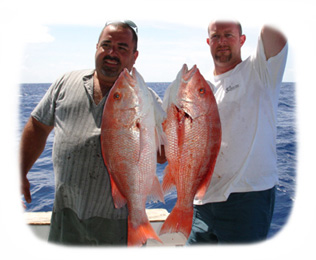|
|
|
Fishing Info
.................................................................................................................................................................................................................................................
Most trips start out with a short 1 hour run past the reef. After we get into some deeper blue water, we slow down to trolling speed, 7-10kts and the trolling lines are deployed. The ride West while trolling takes a bit longer, but depending on the time of the year, some good fish can be cought. Our typical catches include dolphin, tuna, wahoo, king mackarel, sailfish, and an occasional marlin.
Click on the links below to see specific info on catching :
Mutton Snapper Black Grouper Red Grouper
Yellowtail Snapper King Mackarel
Some general fishing tips:
|
Here you will find some useful information for you to experiment with and to help you catch fish. Some of this information is species specific, some is general. Much of it is common knowlege to experienced anglers. I hope everyone will get something new out of this page. Many years of commercial fishing and watching fisherman in action helped me to develop these fishing techniques. They will work in this area most of the time. Fishing conditions are always changing however, and there can be many exeptions to the rules. There are as many fishing techniques as there are fisherman.
Check out the tackle page for some examples of gear that works well for fishing our waters.
Because of our unique, ever changing water conditions it pays to experiment. I am always willing to help out fisherman on their trip, share my experience, and offer suggestions. If you apply the information that is on this page on your next Tortugas trip, you will most likely maximize your fish catching potential.
To help you navigate specific topics faster, I put key words in underline. Click on the blue links at the top of this page to see more specific information on each fish. I will be adding more fishing info here from time to time.
|
Once we get to the good bottom fishing grounds, typicaly in less than 250', we anchor the boat and start bottom fishing. If you are not too familiar with fishing our area, the captain or the mate will be happy to give you tips and suggestions on rigs to use and fishing techniques, so your trip will should be productive.
Usually in our area the fish will go through heavy and light feeding periods, and this usually switches every 6-8 hours. It is a good idea to rest or eat during those not so fishy moments, because when they do start biting, the action can be hot. |
 |
 |
|
|
Always adjust your leader length according to the fishing conditions. 6 feet is good for most bottom fishing situations. Go longer, 8-12 feet when fishing deper water, or when there is strong tide or current.
Leaders are not necessary when fishing line shy fish, like yellowtail snapper, or when casting chunk baits to small dolphin . Just tie the hook directly to the main line, no swivels.
Make all the adjustments to your drag before you hook a fish. For fishing reef bottom, use at least 40 lb. test line, with drag set fairly heavy, just below the breaking point of the line. Black grouper especially have a tendency to go staight for their hiding hole after being hooked, so you need all the stopping power you can apply. Always adjust the drag on the bottom fishing reel before dropping the bait down to the bottom! For faster fish like kingfish, dolphin and other palegics, go lighter in line (20-30lbs.) and lighter drag. If you are not sure, or are not confident with drag adjustments, please ask your captain to help you.
Please, no fluorescent/high-vis line on the boat! I have too many gray hairs as it is. We will definately not be doing any bass fishing. The captain will strip all the high-vis line off your reels and make Christmas decorations out of it!
|
|
 |
|
|
Never leave the reel in free-spool, on a clicker, or bait-runner mode while the rod is unattended. Always have the drag engaged. When the fish strikes and swims off, there will be some tension on the line to set the hook against the fish's jaw. Otherwise, the fish will just spit the bait out. I see more fisherman loose their fish this way than any other way.
In most instances, when you have a bite, you will hook many more fish if you just reel, do not jerk the rod. You do not have to cross their eye balls. This is especially very important the deeper you fish. You can give a slight hook set on the rod after reeling some and after the line becomes tight and the rod doubles over.
During dolphin (mahi-mahi) season which runs from April to August, be sure to have some herring cut and ready to throw to the smaller schoolie dolphin. Use 20-30 lb. line and 4/0-6/0 hook. Also, have a rod rigged and ready with a bigger bait, like a whole herring or a ballyhoo, in case a bigger fish shows up.
|
 |
|
|
|